 |
 |
 |
|
|
|
|
Alef- Model A - 1932
The camera was produced by Alef, Optische Anstalten A. Lehmann,Fürth, in Germany.
The Alef camera was produced in four different models: A; B; B1; C, as the Instruction for our model stated. And further in the instruction: ‘Model A has the normal speed of 16 pictures per second. Models B, B1 and C have the advantage of various speeds.’ However, in the instruction book are specified future changes in new models; in future model A - was planed the speed 24 p/s and 8 p/s.
In next models a button of the speed regulator was placed on the front side, below the lens.
The camera has similar features as the Pathe Motocamera model B.
The body was made of steel metal and crystalline black paint with some chrome fittings.
The camera is in good condition. The case is well used.
The camera features:
- The spring clockwork motor; non rotating key;
- The footage counter in meter; before taking any pictures on a new film the film indicator must be set at zero (Picture 2 - the bottom button);
Pict 2; footage counter; © Anna Vacani
- Exposure 1/ 32 frame per second (fps);
- Only continuous running by sliding starter knob (Picture 2 -starter knob beside the motor key);
- The lens made by Laack Rathenow, in Germany No 252566; 1:3,5 F=2 cm; Interchangeable lens with telephoto lenses and wide angle;
- The optical direct viewfinder is designed in modern way, at that time. It is placed on the top of the camera. Presumably for the cheaper production the viewfinder is inserted in two screws, on the top of the camera (Picture 3);
- The camera is takes “P” charger (30 foot);
- The claw mechanism(Picture 4) ;
- The continental tripod socket.
Production Number: 6750 |
|
Pict 1; Alef Model A; © Anna Vacani
Pict 3; viewfinder;© Anna Vacani
Pict 4;claw mechanism;© Anna Vacani
|
|
|
|
|
|
|
|
Cine Nizo 9½- Model K - 1932 -1933
The camera was produced by Niezoldi & Krämer GmbH (Nizo), Munich in Germany, in 1932 -1933 as it was advertised in an English catalogue -
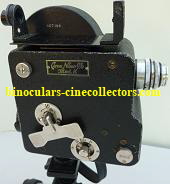 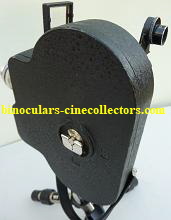
Pict 1; Cine Nizo 9,5 mm Model K; © Anna Vacani
The camera was produced for the English and German market; the description on the camera body is in German and English language. The tripod socket 1/4 inch thread (imperial measurement).
The body was made of a die-cast alloy and crystalline black paint with some chrome fittings. The camera is built like from two chambers: film housing and motor mechanism. The camera is rather heavy about 3 kg, and bigger than others cameras produced at that time.
The camera features:
- The lens: Cooke Kinic made by Taylor Taylor & Hobson Ltd England; 1 inch, f/1,5; the lens is C mount; It is the best quality lens from 1950s; coated lens;
- Direct vision viewfinder with parallax compensation;
- The footage counter is located in unusual way - as a plate in a wheel shape on the rear side of the camera.
- The spring motor, wounded in anti clock way;
- Filming speeds: 8; 16; 24; 32; and 64; Continuos filming and lock run; No single shots
- Back wind slot (right picture - the right bottom corner); the handle is missing;
- 100 ft (30 m) spool loading;
- The film gate and film sprocket are opened and closed by pushing the end of the sprocket guide down and up.
Production Number: 407186
|
|
|
|
|
|
|
|
|
|
Cine Nizo 9½- Model M -1933
The camera was produced by Niezoldi & Krämer GmbH (Nizo), Munich in Germany, in 1933 as it was advertised in an English catalogue. It was next model after model K.
As model K, the camera was produced for the English and German market; the description on the camera body is in German and English language.
 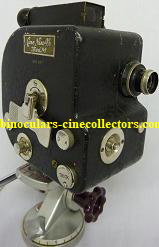
Pict 1; Cine Nizo 9,5 mm Model M; © Anna Vacani
The body was made of a die-cast alloy and crystalline black paint with some chrome fitting. The camera is built like from two chambers: film housing and motor mechanism. The body of this model is built in a little different shape and much smaller than model K.
The weight of the camera is: 1939 grams.
Same features are dissimilar to model K:
- The lens: Anastigmat Cassar 1:2,9 f= 2 cm, made by Steinbeil München No 250536;
- Filming speeds: 8; 16; 24 only; Continuos filming and lock run; No single shots; The camera has exceptional feature, at the time; by key winding is a key slot for hand cranked drive;
- The spring motor, wounded in anti clock way;
- Back wind slot - the right bottom corner; the handle is missing;
- The optical direct viewfinder. It is placed on the top of the camera. The viewfinder is a modern version than model K;
- The footage counter is located on the rear side of the camera. It is much smaller and differently designed;
- The film gate and film sprocket are not changed, only adjusted to the camera size;
- 50 ft (15 m ) spool loading;
- Continental tripod socket;
Production Number: 260457
|
|
|
|
|
|
|
|
|
|
Beaulieu 9,5 mm Model C9- 1951
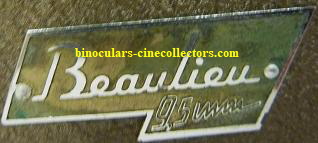
The camera was produced by Beaulieu Industrie, Ramorantin in France. It was the first model of the 9,5 mm camera built up after the change name of the Company. In 1950 the Company - G.I.C. -Groupement Idustriel Cinematographique was taken by Marcel Beaulieu and named Beaulieu Industri.
 
Pict 1; Beaulieu 9,5 mm Model C9; © Anna Vacani
The body is made of a aluminium alloy.
The camera features:
- The lens: Som Berthiot No C62065; Cinor B 1: 1,9 F=20; and wide angle attachment - Som Berthiot Paris No 1130150 Hyper Cinor; C mount lens;
- Viewfinder is parallax compensated; it has mask for telephoto and adjustable for wide angle lens;
- Filming speed 10; 16; 24; 32; 48; 64; Continuous filming; single shot and lock run;
- Film counter;
- The spring motor, wounded in anti clock way;
- Sprocket feed;
- 100 ft spool loading; 50 ft spool in accessories;

- Continental tripod socket;
- Dimensions: 120x110x50 mm; weight - 1641 gram without lens and 1701 gram with lens.
The camera was not sold in the UK.
Production Number: 2201
|
|
|
|
|
|
|
|
|
|
Cinegel Super HL 9,5 mm camera
The camera produced by the Cinegel Co. of Le Mans, France since 1950. The first model of Cinegel camera, at the beginning of the 1950s was produced with film charger.
The camera was named Reinette Cinegel.
Next model of the Cinegel appeared without the word “Reinette” and was named only HL 9, 5 mm. The camera takes spool loading film – 15 meters (50 foot) or 30 meters (100 foot).
Later in 1950s appeared a new model with a triple lens turret interchangeable.
Next model of the Cinegel 9, 5 mm appeared in 1957 as “Super HL 9, 5 zoom camera”, built to take standard “C” mount lenses. Only this model appeared in 1964 into the UK market.
The camera was listed in the March 1965 ACW camera guide, and advertised in Magazine 9, 5 August/September 1964:
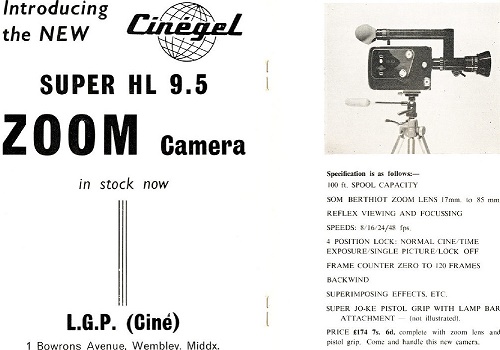
Pict 1; Advertisement of the Cinegel Super HL 9, 5 zoom camera;
The price of the camera was £174. 7s. 6d, including zoom lens and pistol grip. It was very expensive camera, as at the time a small car was priced at £500.
The camera uses the spring motor, clockwork mechanism.
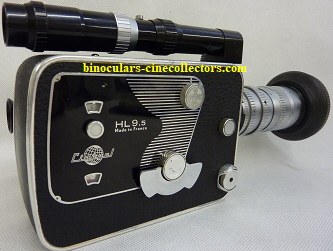
Pict 2; Cinegel Super HL 9, 5 mm camera; © Anna Vacani
- Construction and finished
The body of the camera was made of aluminium and finished partly with textured artificial leather, black paint and with bright metal edges. In same way it is difficult to use the camera, as it does not have any carrying strap. The best and most convenient way is to fit a pistol grip.
- Optical system
Our Cinegel camera is fitted with Bell & Howell Angenieux-Zoom lens; 17-68 mm; f/2.2; production No 778879. Lens was made in France. It is interchangeable lens “C” mount. The lens has an adapter “C” mount to bayonet. It must to be fitted into camera in correct position. Originally the camera was fitted with the Som-Berthiot lens. The Bell & Howell Angenieux-Zoom lens was added by a previous owner.
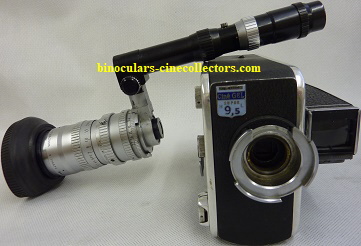
Pict 3; Lens and C mount adapter; © Anna Vacani
The focal length of the lens can be adjusted with the zoom control, by means of ring (in silver colour) on the lens prolonged tube.
Some of these cameras, including our camera, are fitted with auxiliary finder- Bolex octameter type, in the late 70s or early 80s.
This model Octameter viewfinder was lunched to the market in 1950 – the side mounted, parallax compensating viewfinder provide a field of view for lenses of 8 different focal lengths. It is adjustable by a button fitted on a side of the finder. It is a changeable from 1 ½ ft to infinitive for parallax correction.
Field marking numbers are visible inside of viewfinder – below the window, and on the dial – on the top of the viewfinder – numbers; 16; 25; 35; 50; 75; 100; 150 and 10 mm with use of auxiliary lens.
This kind of viewfinder “enabled any standard lens to be used, making the camera even more compact”, as says Graham Murray in his article “Cinegel Super HL 9,5 mm camera”; published in Magazine 9, 5 No 162; Summer 2015.
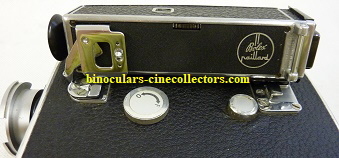 
Pict.4; Bolex Paillard Octameter viewfinder; © Anna Vacani
Our viewfinder, made in Switzerland, is in perfect condition.
The button opening the camera’s film chamber is under the viewfinder. It is easy to separate the viewfinder to access the button, which is marked with letters “O” and “F”.
- External features
On the side of the camera are fitted adjustable features;

Pict 5; External features of the camera; © Anna Vacani
1. Variable speeds button – 8, 16, 24, & 48 fps;
2. Films counter is in meters, and it is running up to 30 meters. When the counter goes to the end of film, it is visible the letter “F”. For re-setting film counter pull up the button bellow the film counter window and adjust to your needs.
3. Frame counter; zero to 120 frames.
4. Input for hand crank for backwind. To rewind a film you have to push release button and rewind using the hand crank.
5. Release button for letter “N” is normal running, turning button further it is continuous running
and letter “I” is for single frame exposure. Position “B” on the release button is for locking filming. Cable realise can be fitted into realise button.
6. Winding key. The one wounding of the motor will run as Graham Murray says “In my experience the Cinegel only manages a little over half [of 25 ft film]”
- Type of loading and transit mechanism
The camera has a peculiar method of loading and transit mechanism. Both spools are fitted on the same spindle. The bottom spool is the feed one, and the top is taken up film. As Graham Murray pointed - “The Cinegel’s principal advantage is its compact size, achieved by mounting feed and take-up spools coaxially, although limits the length of film which can be back wound, as the feed spool is not geared”.
 
Pict 6&7; Cameras’ chamber & example of mounted feed and take-up spools; © Anna Vacani
Each spool supplies the film into single sprocket. The sprockets are in the shape of a tower.
It is most unusual not to have a film loading diagram inside of the camera.
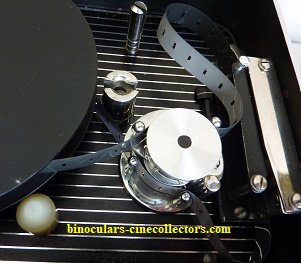
Pict.8; Both spools loaded with a film – feed & taken up; © Anna Vacani
The gate is opening for film loading and for cleaning.
- Dimensions of the camera
Dimensions – L 160 mm x H 115 mm x D 55 mm (0,52 ft x 0,37 ft x 0,18 ft) ;
- Weight – only camera – 1537 g + 675 g lens + 205 g viewfinder = 2417 g (3.38 pound x 1, 48 x 0, 45 = 5.32 pound).
It looks as the camera is very heavy; however the centre of gravity of the camera is precisely calculated. By that means the real weight of the camera is not noticeable. In this way, the burden of the camera is imperceptible.
- Accessories
The camera is supplied with one 100 meter spool and back-wound hand crank. It does not have a camera case and pistol grip.
Production No; BB1323
- Summarizing
It is a very impressive camera, particularly with this massive lens mounted to the camera. Optically it is very well equipped. In this way the film maker has a lot of support from the optical features from this camera, and gives him the opportunity to make a very sharp film.
Additionally the camera has frame counter. Hardly ever the cameras are supplied with this feature.
Notice
The description of the camera was based on the owners’ knowledge and decades of experience. Furthermore it is based on the knowledge from many kinds of Cine literature, as well.
|
|
|
|
|
|
|
|
|
|
Miller camera 9,5 mm; model B de Luxe
According to ACW, the Miller cameras were built since 1930s by company – Miller Cine Co. Ltd, Elmbridge Road, Gloucester and next at new address - Miller Cine Co. Ltd, 106 Barton Street, Gloucester, in the UK.
Some features of the camera were patented – governor and the gate presser pad.
In 1934 appeared the first model, announced in April ACW magazine. It was camera with 30ft Standard Pathe “P” chargers.
The camera was covered with leather. It was advertised as “Strong metal body, covered finest morocco leather, all metal parts chromium plated.”
It was priced from £10 10 0 to 16 10 0 depending on the lens model.
In June 1939 ACW magazine published “Test reports of New Apparatus” – Miller Cine Camera 9, 5 mm Model B de Luxe. It was two models with little differences; one had a different way of fixing the door – it was hinged at the rear of the camera. Other one has the door hinged at the front of the camera and in addition it has one new feature – an inching knob.
The cameras were not produced during WWII.
After the WWII the company resumed production of the cameras but only 8 mm model. The design was absolutely different from the pre-war models.
Our two cameras are 9, 5 mm, model B de Luxe.

Pict 1; Miller model B de Luxe 9, 5 mm camera; © Anna Vacani
The camera takes 30 ft charger. It can be “P” Pathe charger or “H” smaller charger.
Construction and finish
The body is constructed from die cast alloy and finished with black crackle enamel. All the fittings are being chromium finished. At the top of the camera a leather handle is fitted with logo –“Miller Cine”.
The door is hinged at the front of the camera and it has an inching knob.
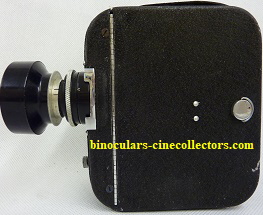 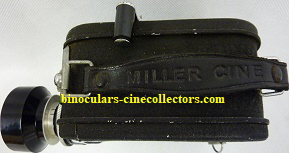
Pict 2; Miller model B de Luxe 9, 5 mm camera; the door & marking handle; © Anna Vacani
As it was described in ACW June 1939 – “The door is hinged with a small piano-type hinge extending the full height of the camera, near the front, and the turned button catch is fitted at the rear.”
In the earlier version the catch button was placed by release button, in the front of the camera.
External features:
On one side the camera has 5 features.
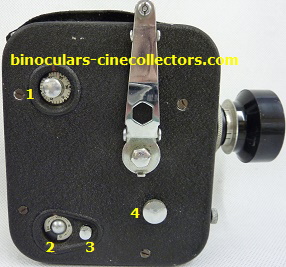
Pict 3; Miller model B de Luxe 9, 5 mm camera; external features; © Anna Vacani
- Footage meter (1)
The film counter is in foots. The meter is divided into 30 parts of one foot. “This moves forward intermittently, making 7 movements for each 5 feet of film” it says in the review. This model of the camera has inching knob as well. (4)
- The speed control and motor
The speed control (2) is marked as – 8, 16, 64 fps. On the right by the speed control “is a small knurled knob which can be used to turn the mechanism when treading, and thus check the correct running of the film.” (3)
When the motor, clockwork drive, is fully wounded with the winding key, it will run off the full film charger.
- Optical system
One of our cameras is filled with a J H Dallmeyer London uncoated lens “Speed” Anastigmat F/1.5 F=20mm; Serial No 180283.

Pict 4; J H Dallmeyer “Speed” Anastigmat F/1.5 lens; © Anna Vacani
On the top front of the camera is the window of the viewfinder with the scanning field suitable for the 20mm lens and visible engraved mask line and masks for 50 mm and 75 mm telephoto. (Pict 1)
- Type of loading and transit mechanism
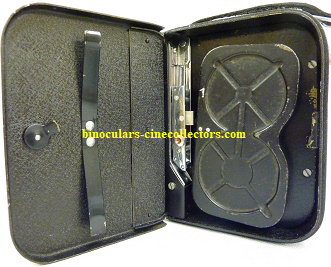 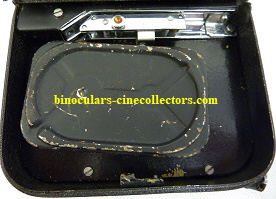
Pict 5; Miller model B de Luxe 9, 5 mm camera; chargers “P” and “H”; © Anna Vacani
The camera takes 9, 5 mm charger. The shutter is of the single bladed swinging type. The camera door holds the charger firmly in position.
The gate in the chamber is flat, but the presser plate is channeled and it prevents to scratch the film, when passes.
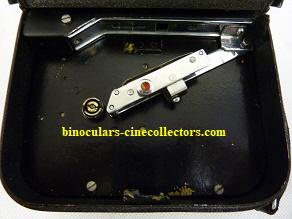
Pict 6; Miller model B de Luxe 9, 5 mm camera; the gate (opened) & presser plate; © Anna Vacani
There is a double claw intermittent and a take up drive of the regular pattern.
- Realise button
At the front of the camera is the realise button. This has three positions: single picture, continuous running and lock position. To find a position the button must be pressed and turned into a required position. (Pict. 1)
- Dimension of the camera
The camera dimension is - 5 ¾ = 146.05mm high; 5 1/1= 152.4mm deep; 2 ¾= 69.85 wide.
As ACW mentioned it was a little larger 9, 5 mm camera, at that time.
Weight – 3, 49 lb – 1500 grams; without lens 3, 16 lb 1406 grams.
- Accessories
Our camera is supplied with lens hood. Usually those cameras were not sold with lens hood. It was as accessories to the cameras in many different sizes. (Pict. 3)
Production numbers;
The cameras are produced in the same period, because the numbers are a little different; - 2452 and 2531.
- Summarizing
It is a very impressive camera, as ACW mentioned it was a little larger 9, 5 mm camera, at that time.
The camera was produced just before WWII. The review of the camera in ACW was published in June 1939, as “New Apparatus”. We can draw a conclusion, that the camera was shortly produced and the production was closed in early autumn 1939.
Optically the camera is very well equipped. The lens is produced by well known The J H Dallmeyer. It was a British Company founded in 1860. Mainly it was manufactured lenses. The Dallmeyer company was issued the catalogues “J H Dallmeyer Ltd Manufacturers and patentees of Photographic, Cinematograph, Lenses, Cameras& Apparatus”
The Dallmeyer company was dissolved in 1993.
Notice
The description of the camera was based on the owners’ knowledge and decades of experience. Furthermore it is based on the knowledge from many kinds of Cine literature, as well.
|
|
|
|
|
|
|
|
|
|
Page Back pages: (1) (2) (3) (4) (5)
|
|
|
|
|